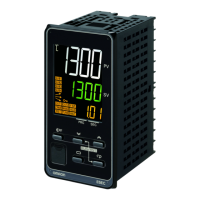1 Introduction
1 - 4
E5@C-T Digital Temperature Controllers User’s Manual (H185)
• Holding
• Waiting to advance to the next segment
• Jumping to segments with a key operation
Program Status Outputs
• Time signals
• ON output in run status
• ON output at program end
• Stage outputs (one-pulse output at start of each segment)
z Adjusting PID Constants
• You can easily set the optimum PID constants for the current PID set or for all PID sets by
performing AT (auto-tuning) with the limit cycle method .
• You can also add RT (robust tuning) to give priority to controlling stability.
z Alarms
Standard Alarms
• You can output an alarm when the deviation, process value, set point, or manipulated value
reaches a specified value.
• You can also output alarms for the PV rate of change and for loop burnouts.
• If necessary, a more comprehensive alarm function can be achieved by setting a standby
sequence, alarm hysteresis, auxiliary output close in alarm/open in alarm, alarm latch, alarm ON
delay, and alarm OFF delay.
HB and HS Alarms
• With models with the optional HB and HS alarms, you can detect heater burnout and heater short
alarms based on CT inputs.
Integrated Alarm
• You can output an integrated alarm if a standard alarm, HB alarm, or HS alarm turns ON.
z Event Inputs
• With any model that supports event inputs, you can use external contact or transistor inputs to
achieve any of the following functions: You can control the following: changing programs
(changing program number, 8 max.), changing between run and reset status, changing between
automatic and manual operation, inverting direct/reverse operation, changing between program
SP and fixed SP, 100% AT execute/cancel, 40% AT execute/cancel, 100% AT execute/cancel for
all PID sets, 40% AT execute/cancel for all PID sets, setting change enable/disable,
communications write enable/disable, canceling the alarm latch, hold/clear hold, advance, and
wait enable/disable.
z Communications Functions
With any E5@C-T model that supports communications, you can use CompoWay/F, Modbus-RTU,
*1
programless, and component communications.
*1 Modbus is a registered trademark of Schneider Electric.
z Transfer Output
With any model that provides a transfer output, you can output the set point, process value,
manipulated variable, or other values as a 4 to 20-mA or 1 to 5-V transfer output.

